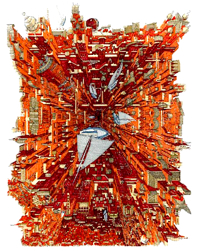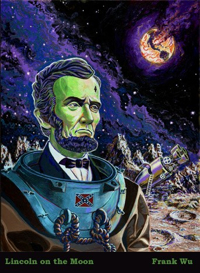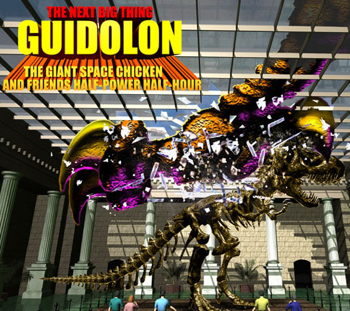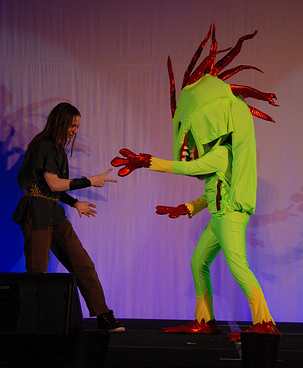
At my first Arisia, I found myself weaving through crowds of strangely-coiffed pirates, rocketeers, and gamers; wondering at what point my own personality would intersect with one of those cliques and, at the same time, idly speculating as to which clique it would be. Twisting, turning, and meandering, I wondered if there was any cipher concealed for me in my conversations with Freemasons, swordsmen, and zombies, or a secret buried somewhere in the depths of a prominent decolletage. In the end I was left with an exhilarating sense that something interesting had transpired, and though I could list any number of particulars of the fun things I did, I wasn’t quite sure how it all added up. This year, at my second Arisia, I was more accustomed to the casual ebb and flow, the meaningless randomness of who one might meet at any given moment, and I was more attuned to simply enjoy the dance. Indeed, some of the most startling appearances in 2009 — the stilt-walking woman in tights and razor claws, the body-gloved Harley Quin, and the immaculately nuanced Steampunk ensembles — returned. They were all conspicuously different from last year, but instead of novelty they radiated a pleasant warmth of familiarity.

[photo by Sean Molloy - http://www.flickr.com/photos/falconn67/]
It was equally reassuring to see pieces of last year’s favorites, if not ramped up to full energy, at least lying about here and there like fragments left over from an archaeological dig. The skull-bracketed rocket pack that was flamboyantly posing with a team of rocketeers in ‘09, was this year merely glimpsed abandoned on a table, straps dangling idly alongside. It certainly would have been fun if somebody rushed out of the con-suite, strapped on the skull-pack, and flamed up across the atrium space to a party upstairs! And yes, there were pirates, there were faeries, and furries, and a few storm trooper types. You could say that it was the same rich stew of individuals at Arisia 2010, but there were definitely higher concentrations of bare feet, of blood-drenched nurses, blue-green body paint (though only a few of them Navi, as fas as I could tell), and really pervasive wearing of kilts. Sure, some people I expect to see wearing a kilt (since that’s pretty common around the office…okay, it is Cambridge!), but it seemed like every time I turned around there was another utilikilt wrapped around some smiling, bearded dude. Which means that this year’s Arisia (officially sub-titled “the future and the past”) has been informally dubbed by Yunchtime as the “barefoot techno-fantasy fest, in a kilt.”
The first session I attended was Costume Tech, which appears once every several years, and introduces all the amazing lighting, audio, video, and staging of the famous masquerade. The presentations did not go into specific types of gear or software applications, but rather provided some tips and procedures that come in handy for running such a large scale production. For anyone who hasn’t witnessed the Arisia masquerade, you have to picture the mind-boggling problem of walking into a gigantic empty and echoing ballroom that has to be transformed into a major stage production, including the assembly and testing of not only the stage itself, but 20-ft high lighting racks, four live video camera feeds, wireless and wired sound systems, intercom for crew communication, footlights, a 30-ft wide cyclorama background screen, and all the comcomitant cables, amplifiers, multi-channel mixing boards, and their fanatically devoted human handlers who actually get it all to work! This was a truly fun and educational session, complete with a neat 8 page handout. It inspired me to grab Hobbit in a hallway later on and ask him about the WholeHog.
I’ve been told: what transpires in Thomas Paine, stays in Thomas Paine… But, if you really need to know, word on the street is that secret testing has emerged from the Colors and Lights laboratory and some innocent guinea pigs were spotted around a strange new gameboard amidst the general tumult at Arisia 2010. Maybe in 2011 we’re going to see a cool game launch! But it’s just a rumor…
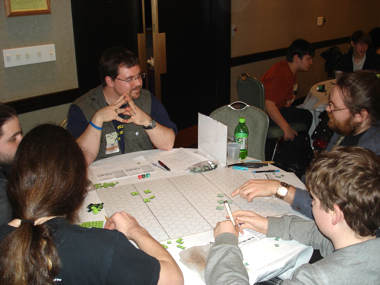
At the Science Fiction / Science Fact panel, experts delved into the ways in which sfnal ideas manifested themselves in the real world. Obvious examples are:
Star Trek Communicator -> cell phone…
voice-activated devices - > speech recognition…
robots -> robots…
flying car -> in Boston, we don’t go there!
On the theme of robots, Mark Amidon (of iRobot) explained why military research is often driving innovations on the sfnal edge. “For industrial products, you have to pay in advance for all your own R&D, and only after you actually have a useful product can you begin to sell it and try to recoup your investment. On the other hand, the Dept of Defense is going to pay for everything up front, as long as you can demonstrate that your research is moving towards supplying them with a cost-effective solution. For example, if you have guys getting shot up at the point of engagement, you want to get them out of there and put robots in the line of fire. Now if you were developing a commercial product line of robots, it would take forever to make enough money to offer a product that could handle those conditions, but all the military wants is cost-effectiveness: will it take the first round of enemy fire? If the answer is yes, they’ll pay for the research, testing, and production.”
Alan Wexelblat (MIT Media Lab grad, who “knows next to nothing about everything”) was fascinated by the ways in which robots have been adopted into the societies of Japan and Korea. There, unlike in the U.S., robots are being widely used for home care of the elderly. Those robots, though they are far from AI, have a sort of two-stage intelligence. “In the first stage the robot behaves according to some preset patterns, such as asking if medication has been taken, or if they detect sudden motion, like a person slipping or falling down, they are able to react by asking if help is needed. But the really interesting thing is that the robot is able to make a judgement about when it’s own pre-programmed behavior is not adequate, at which point the robot’s screen will turn itself off and be replaced by a live video-call connection to an actual human nurse. In the U.S. we’re a long way from having that sort of interaction with our robots.”
That doesn’t mean that people don’t get attached to their Roombas! Avidon retold the story about the bomb-detection robot, nicknamed by its human handlers “Scooby Doo,” that was destroyed during operations in Iraq. The soldiers were so emotionally attached to the device, that contravening all procedures when Scooby Doo was blown up, one of the men ran directly into the danger zone, swept up the pieces of the robot and ran them back to the shop, where he asked “can you fix him?”
“This just took us completely by surprise,” said Avidon, “because we had no idea how involved these people would become with their machines. We had users writing us to ask: where do I enter the name of my robot? because we can’t find it in the manual… The name? We never thought that these bomb units were going to need a name programmed into them!”
On the topic of neuro-informatics, the science that combines the analysis of how our brains work with computational models, Will Howitt said that we are not going to upload our brains into a computer anytime soon. Taking full cochlear implants as a point of comparison, Howitt said that the number of nerve connections needed to succeed in replacing a human ear is something that we can already achieve with limited results. But the entire central nervous system is so many orders of magnitude more complex, that mapping those connections to simulation models is something that we may never achieve.
In terms of what SF gets right and wrong about predicting the future, Wexelbatt remarked “SF can be really good at anticipating new technology, but awfully bad at describing social changes caused by new technologies. There were any number of SF stories that used the concept of the Internet as a communication device for scientific and military applications, but how many described it in terms of our ten-year old daughter organizing her slumber party on Facebook?”
The only film I watched on Saturday was a strange documentary short, “Life on Other Worlds,” from 1961. This must be something that Scott Dorsey dug up from NASA or the National Archives. The only info I could find out about this film was on the history page of KUHT, America’s oldest Public Television Station. According to that source, “Life on Other Worlds” was the last episode of “Doctors in Space,” a 13-part look at aviation medicine centered around the School of Aviation Medicine at San Antonio’s Randolph Air Force Base.
The 22 minute film did not look like it was shot in Texas, though…it took place in some gigantic ballroom, probably in New York City, and the announcer mentioned something about thanks to Seagram’s, no doubt the sponsor of the Doctors in Space series. Irony? Rotgut whiskey pays for space medicine? Oh, glory be, what a nice concept! In the ballroom were hundreds of guests, the majority of them men, and each of those men was industriously puffing or chomping on either a cigaret or a cigar. Facing the audience on stage left was a panel of journalists: Walter Cronkite, Chet Huntley, and the science correspondent of the New York Times. Chet Huntley was obviously the major in those days, he had all the face time on camera, and sat there looking serious and sad, smoking butts, and squinting from some serious bags under his eyes. In order to be a respected journo in those days you really had to drink a gallon of whiskey per day, smoke ten packs of Pall Malls, and only get 15 minutes of sleep in a cab between the Algonquin Club and a Remington typewriter. And you could read it all in Huntley’s eyes, that poor bastard!
The panel of scientists included Arnold Toynbee, Harlow Shapley, and several other dignitaries of chemistry, sociology, and astronomy. After giving opening statements on the number of stars in the known Universe and the likelihood of finding planets that can sustain life on them, the scientists took questions from the journalists. The interesting thing about watching this film 50 years later, is to realize how similar in many respects the informed viewpoint of extra-terrestrial life was to our own. Shapley had previously said, “In the beginning was the Word, and I might venture that the word was hydrogen gas,” which made him a villain to some Creationists, but was quite consistent with his view that by every indication naturally evolved life forms did, and still do, exist on other planets. As for Venus and Mars, Shapley and his fellow scientists remarked on the extreme heat and cold of those planets, and made predictions about what we would find on those worlds that is remarkably consistent with all the facts that we have subsequently discovered.
When Huntley asked the scientists what question they would ask an alien intelligence, if and when humans did establish radio signal contact with them, the sociologist replied, “ I would ask them: what do you want to know about _us_?” This gave me pause to consider — probably it’s very true that you’d have to be totally alien and light years away with absolutely no previous experience of the human race in order to actually WANT to know anything about us… Finally, I should note Toynbee’s concluding remark, “We should be trying to make contact with the spiritual worlds in ourselves first, rather than physical worlds in the external Universe,” which sounds a heck of a lot like the objective behind New Wave of SF occurring at roughly the same time. Altogether this was a fine gem of an old newsreel, and I’ve spent some extra wordage on it because it simply doesn’t exist on Youtube.
At the Art Show this year was a fine selection of GOH Sarah Clemens works, and some very intricate architectural maze-like drawings by Yossi Vesseid. But the highlight, in my opinion, was a hilarious print of a drawing by Frank Wu, called Lincoln on the Moon, featuring a zombie green-faced analog of the 16th President sporting a Confederate flag (!) on his space-suit, while his small steampunk rocketship sits in the moonscape behind him, and a burning earth hangs in a purple sky. Just a crazy and fun image, to be sure!
Frank Wu also participated in the dueling easels event, alongside E. J. Dionne and Matt Ryan. Sharpie pens blazing, and fans in the audience heckling, the three artists sketched up a storm in (fairly loose) relation to passages read from several SF and Fantasy books. E. J. Dionne’s sketches appeared in a fanciful, curvy style, and included a pretty neat floating skull with red eyeball dripping out and wearing a studded medieval cap. Frank Wu’s whiz-bang sketches featured such oddities as giant insects flying a spaceship wearing steampunk boots and goggles…but those details really appear in Welle’s First Men in The Moon, insisted Wu, “I didn’t make the shit up!”
Also on the theme of art, Frank Wu presented an updated version of the animation trailer for Guidolon, Giant Space Chicken, at the Kaiju session. Guidolon, you must understand is from Guido, the character in Fellini’s film, 8 1/2, in which Fellini is making a film about Guido, who is making a film about making film. Therefore, it is easy to understand why Guidolon, the Giant Space Chicken from Tokyo (circa 1977…the future Tokyo 1977), is a giant kaiju monster that is trying to make a movie about giant kaiju monsters. Frank Wu has the whole rationale of this hilarious movie-in-the-making down pat: “We are all suspended in existential angst between the giant powerful creatures that we wish we really were, and the chicken that we really are. Hanging in that amorphous space, is where we find out if we can truly define ourselves or if others will define us.” I guess you could say that Guidolon is sort of a cross between Superchicken and Spiderman, on goofballs, as made by Toho Studios.
So, if any of you zillionaire producers out there are wondering which animation project you want to see on the big screen, then jet your browsers on over to Guidolon and let’s get that Space Chicken onto the big screen! Did I mention that it’s a Giant Kaiju Space Chicken? With existential angst? What are you waiting for!
Where the heck do we go from here? Keep tuned for another post on Gardner Dozois, the Arisia 2010 GOH, and on the future of small press SF publishing.
